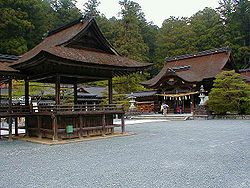- Oguni Jinja
-
Oguni Jinja
小國神社
Honden and Maidono of Oguni Jinja Information Dedicated to Ōnamuchi-no-mikoto Address 3956-1 Mori-machi, Shūchi District, Shizuoka Phone 0538-89-7302 Website Homepage The Oguni Shrine (小國神社 Oguni Jinja) is a Shinto shrine in the town of Mori in Shūchi District Shizuoka Prefecture, Japan. Oguni Jinja (also called Okuni Jinja) is one of two shrines claiming to hold the title of ichinomiya of former Tōtōmi Province. The main festival of the shrine is held annually on April 18, during which time a set of twelve dances are performed. This performance is said to date to the early Heian period and is a National Intangible Cultural Property.
Contents
Enshrined kami
The primary kami of Oguni Jinja is the Ōkuninushi (Ōnamuchi-no-mikoto 大己貴命). There are numerous small subsidiary shrines to various kami within the shrine grounds.
History
The date of Oguni Shrine’s foundation is unknown. Shrine tradition gives a date of February 18, 555 (during the reign of Emperor Kinmei as the date when a shrine was first constructed on the 511-meter Mount Hongū, which now forms part of the shrine’s grounds.
The shrine appears in historical records in an entry within the Shoku Nihon Kōki dated June 14, 884 and it is mentioned again in the Engishiki records.
It has been styled as the ichinomiya of Tōtōmi Province since at least 1235, and continued to be referred to as the “Ichinomiya” until the end of the Edo period. Takeda Shingen worshipped at the shrine in 1572, and Tokugawa Ieyasu in 1575. Ieyasu later contributed to the rebuilding of the Honden, and subsequent generations of Tokugawa Shogun continued to support the shrine.
After the Meiji Restoration, it was proclaimed a prefectural shrine (県社) in 1873, and was granted the rank of Kokuhei Shōsha under State Shinto in 1875. [1]
See also
Notes
- ^ Ponsonby-Fane, Richard. (1959). The Imperial House of Japan, pp. 125.
References
- Plutschow, Herbe. (1996). Matsuri: The Festivals of Japan. London: RoutledgeCurzon. 10-ISBN 1-873-41063-8
- Ponsonby-Fane, Richard Arthur Brabazon. (1959). The Imperial House of Japan. Kyoto: Ponsonby Memorial Society. OCLC 194887
Coordinates: 34°50′51″N 137°53′57″E / 34.8475°N 137.89917°EShinto shrine Shinto architecture Buildings - chōzuya or temizuya
- haiden
- heiden
- hokora
- honden / shinden / shōden
- kagura-den
- massha
- sessha
Architectonic elements Styles - hirairi-zukuri
- tsumairi-zukuri
- gongen-zukuri
- hachiman-zukuri
- hiyoshi-zukuri
- irimoya-zukuri
- ishi-no-ma-zukuri
- kasuga-zukuri
- kibitsu-zukuri
- misedana-zukuri
- nagare-zukuri
- ōtori-zukuri
- owari-zukuri
- ryōnagare-zukuri
- shinmei-zukuri
- sumiyoshi-zukuri
- taisha-zukuri
Others Implements Main kami Staff Head shrines1 - Fushimi Inari Taisha
- Usa Hachiman-gū
- Ise Grand Shrine
- Dazaifu Tenman-gū
- Munakata Taisha
- Suwa Taisha
- Hiyoshi Taisha
- Kumano Nachi Taisha
- Tsushima Shrine
- Yasaka Shrine
Miscellaneous 1 (in order of the size of the shrine network they head)
Categories:- Shinto shrines in Shizuoka Prefecture
Wikimedia Foundation. 2010.
